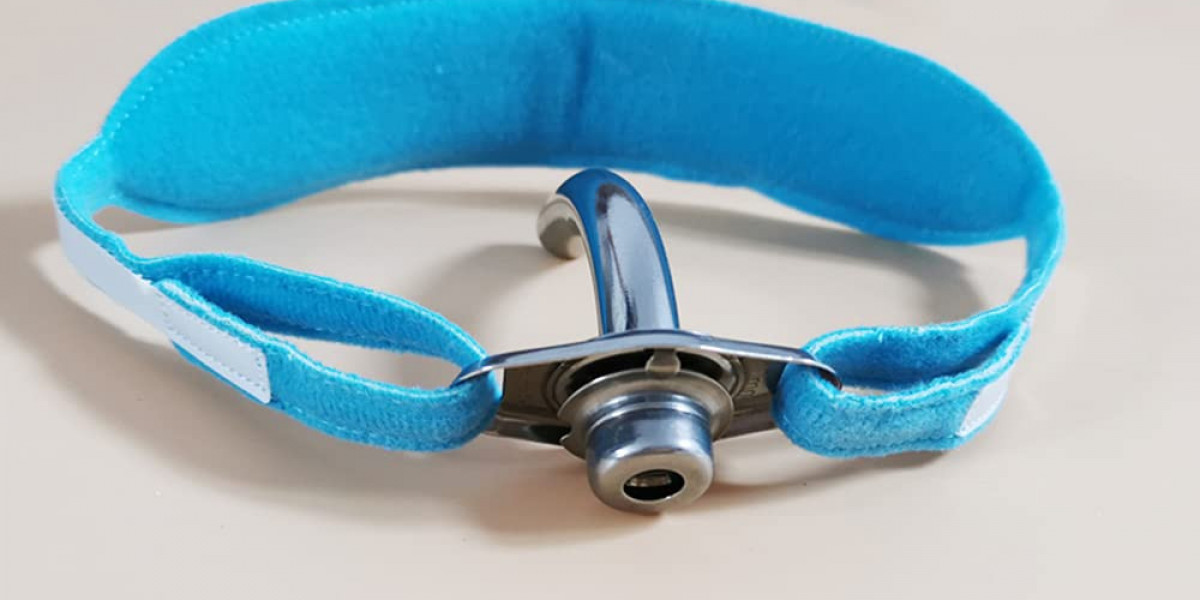Are you familiar with the term "tracheostomy collar"? If not, get ready to discover an innovative and game-changing device that is revolutionizing patient care. In today's blog post, we will dive deep into the world of tracheostomy collars and explore how they can significantly enhance both comfort and care for patients undergoing this procedure. Whether you are a healthcare professional searching for ways to improve your patients' well-being or simply curious about cutting-edge medical advancements, this article is a must-read! So join us as we uncover the incredible benefits of tracheostomy collars and learn why they have become an indispensable tool in modern medicine.
What is a Tracheostomy Collar?
A tracheostomy collar, also known as a trach collar, is a medical device used in patients with a tracheostomy tube. It is designed to improve patient comfort and care by providing support for the tracheostomy tube and allowing for easier breathing.
A tracheostomy is a surgical procedure in which an incision is made in the front of the neck to create an opening into the windpipe (trachea). This creates an alternate pathway for air to enter the lungs when the normal route through the nose and mouth is blocked or compromised, such as in cases of upper airway obstruction or respiratory failure.
After a tracheostomy procedure, patients may experience difficulty breathing due to changes in their anatomy. The use of a trach collar can help alleviate these difficulties by providing stability and support for the newly created opening in the neck. It consists of a soft foam neck strap with adjustable fasteners that secure it comfortably around the patient's neck. The collar also has two plastic pieces that fit under and around the edges of the trachea tube, keeping it securely in place.
Why are Tracheostomy Collars Used?
Tracheostomy collars are specialized medical devices that are used to secure and support a tracheostomy tube, which is a small artificial airway that is inserted into the neck to allow for breathing. These collars have been designed to improve patient comfort and care in individuals who require long-term use of a tracheostomy tube.
There are several reasons why tracheostomy collars are used, including:
- Stabilization of the Tracheostomy Tube:
One of the primary reasons why tracheostomy collars are used is to stabilize the tracheostomy tube in place. These collars come with adjustable straps that can be securely fastened around the neck, preventing any movement or displacement of the tube. This not only ensures proper placement of the tube but also reduces the risk of complications such as accidental extubation or infections.
- Improved Patient Comfort:
Patients who require long-term use of a tracheostomy tube often experience discomfort due to constant irritation from securing tapes or ties around their necks. Tracheostomy collars provide a more comfortable alternative as they distribute pressure evenly around the neck area, reducing skin breakdown and discomfort.
Benefits of Using a Tracheostomy Collar
Tracheostomy collars are medical devices that are designed to be worn around the neck and cover the stoma, or opening in the throat, created by a tracheostomy tube. They can be used for patients who have undergone a tracheostomy procedure, which involves creating an opening in their windpipe to help them breathe.
Here are some of the key benefits of using a tracheostomy collar for patients:
- Improved Comfort and Mobility: One of the main benefits of using a tracheostomy collar is that it provides increased comfort and mobility for patients. The collar helps to secure the tracheostomy tube in place, reducing any movement or shifting that may cause discomfort for the patient. This allows them to move more freely without worrying about their breathing tube becoming dislodged.
- Protection from Infection: Another important benefit of using a tracheostomy collar is that it helps to protect against infection. By covering the stoma with a barrier, it prevents harmful bacteria or particles from entering the airway and causing respiratory infections. This is especially crucial for patients who have weakened immune systems or are at risk for respiratory complications.
How to Properly Use a Tracheostomy Collar
A tracheostomy collar is a medical device used to provide support and stability to the tracheostomy tube, which is inserted into a patient's windpipe through a surgical incision in their neck. It is an essential tool for patients who require long-term ventilation or have difficulty breathing on their own.
Proper usage of a tracheostomy collar is crucial for ensuring patient comfort and care. In this section, we will discuss the steps involved in using a tracheostomy collar correctly.
Step 1: Preparing the Patient
Before placing the tracheostomy collar on the patient, it is important to ensure they are in a comfortable position. The head should be slightly elevated, and any excess secretions should be cleared from around the stoma (the opening where the tracheostomy tube is inserted).
Step 2: Selecting the Right Size Collar
Tracheostomy collars come in various sizes to accommodate different neck circumferences. It is essential to choose the correct size that fits snugly around the patient's neck without causing any discomfort or pressure points.
Step 3: Inspecting and Assembling the Collar
Before placing it on the patient, inspect the collar for any signs of damage or wear and tear. Make sure all straps are intact and functioning correctly. Then, assemble all parts of the collar according to manufacturer instructions.
Tips for Maintaining and Cleaning a Tracheostomy Collar
Maintaining and cleaning a tracheostomy collar is essential for ensuring its effectiveness and prolonging its lifespan. Here are some tips to help you properly maintain and clean your tracheostomy collar:
- Clean the Collar Daily: It is important to clean your tracheostomy collar daily to prevent any build-up of bacteria or debris. Use a mild soap and warm water to gently wash the collar, making sure to remove any secretions, sweat, or dirt that may have accumulated.
- Rinse Thoroughly: After washing the collar, make sure to rinse it thoroughly with clean water. Any leftover soap residue can irritate the skin and cause discomfort for the patient.
- Dry Properly: After rinsing, use a clean towel or cloth to pat dry the collar. Avoid rubbing as this can damage the fabric or irritate the skin around the tracheostomy site.
- Disinfect Regularly: In addition to daily cleaning, it is recommended to disinfect your tracheostomy collar regularly using an antimicrobial spray or wipes specifically designed for medical equipment. This will help kill any bacteria that may have survived the daily cleaning routine.
- Check for Wear and Tear: It is important to inspect your tracheostomy collar regularly for any signs of wear and tear such as frayed edges or loose Velcro straps. If you notice any damage, replace the collar immediately as it can compromise its functionality and cause discomfort for the patient.
Alternatives to Tracheostomy Collars
Tracheostomy collars, also known as trach collars, are medical devices used to secure a breathing tube in the neck of a patient who has undergone a tracheostomy procedure. They provide stability and support for the tracheal tube, allowing patients to breathe more easily and comfortably. While trach collars are commonly used in hospitals and other healthcare settings, they may not be suitable for all patients. In this section, we will explore some alternative options to tracheostomy collars that may better suit certain individuals.
- Tracheostomy Ties
Tracheostomy ties are similar to trach collars in terms of function – they both secure the breathing tube in place - but differ in design. Unlike the collar which wraps around the neck, ties consist of two straps that go around the back of the patient's head and attach to the sides of the tracheal tube. This can be beneficial for patients with larger necks or those who have difficulty tolerating pressure on their necks
- Montgomery Straps
Montgomery straps are another alternative to trach collars that offer a more customizable fit for patients with unique needs. These straps consist of adhesive strips attached to either side of the skin surrounding the stoma (the opening created during a tracheostomy). The ends of these strips can then be tied together at varying lengths depending on how tight or loose each patient requires them.
Real Life Success Stories
Tracheostomy collars have been proven to be incredibly beneficial for patients requiring tracheostomies, allowing them to breathe easier and improving their overall comfort and care. But what do real life success stories look like? How have tracheostomy collars truly made a difference in the lives of patients?
Let's take a closer look at some inspiring real life success stories that highlight the impact of using tracheostomy collars.
- Improved Breathing and Comfort: One of the most common reasons for using a tracheostomy collar is to help patients breathe easier. This was exactly the case for Sarah, who suffered from severe respiratory distress due to chronic obstructive pulmonary disease (COPD). After undergoing a tracheostomy procedure, Sarah struggled with discomfort and difficulty breathing until she was fitted with a tracheostomy collar. With its adjustable straps and soft foam padding, Sarah found immediate relief and could finally sleep soundly at night without feeling suffocated.
- Increased Mobility: For many patients with tracheostomies, mobility can be greatly limited due to cumbersome equipment or fear of dislodging their tubes. Such was the case for John, who had been bedridden for months after his surgery. However, once he started using a tracheostomy collar that provided secure support for his tube while also allowing him to move around freely, John regained his independence and could leave his bed without worry.
Conclusion: Importance of Comfort and Care in Medical Treatment.
It is evident that comfort and care play a crucial role in medical treatment. As healthcare professionals, it is our responsibility to ensure that our patients not only receive the necessary medical attention but also feel comfortable and cared for during their treatment journey.
Tracheostomy collars are just one example of how simple interventions can greatly improve patient comfort and care. By providing support for the trachea, these collars help prevent complications such as skin breakdown, irritation, and discomfort for patients with a tracheostomy tube. This results in improved overall well-being and better outcomes for patients.



